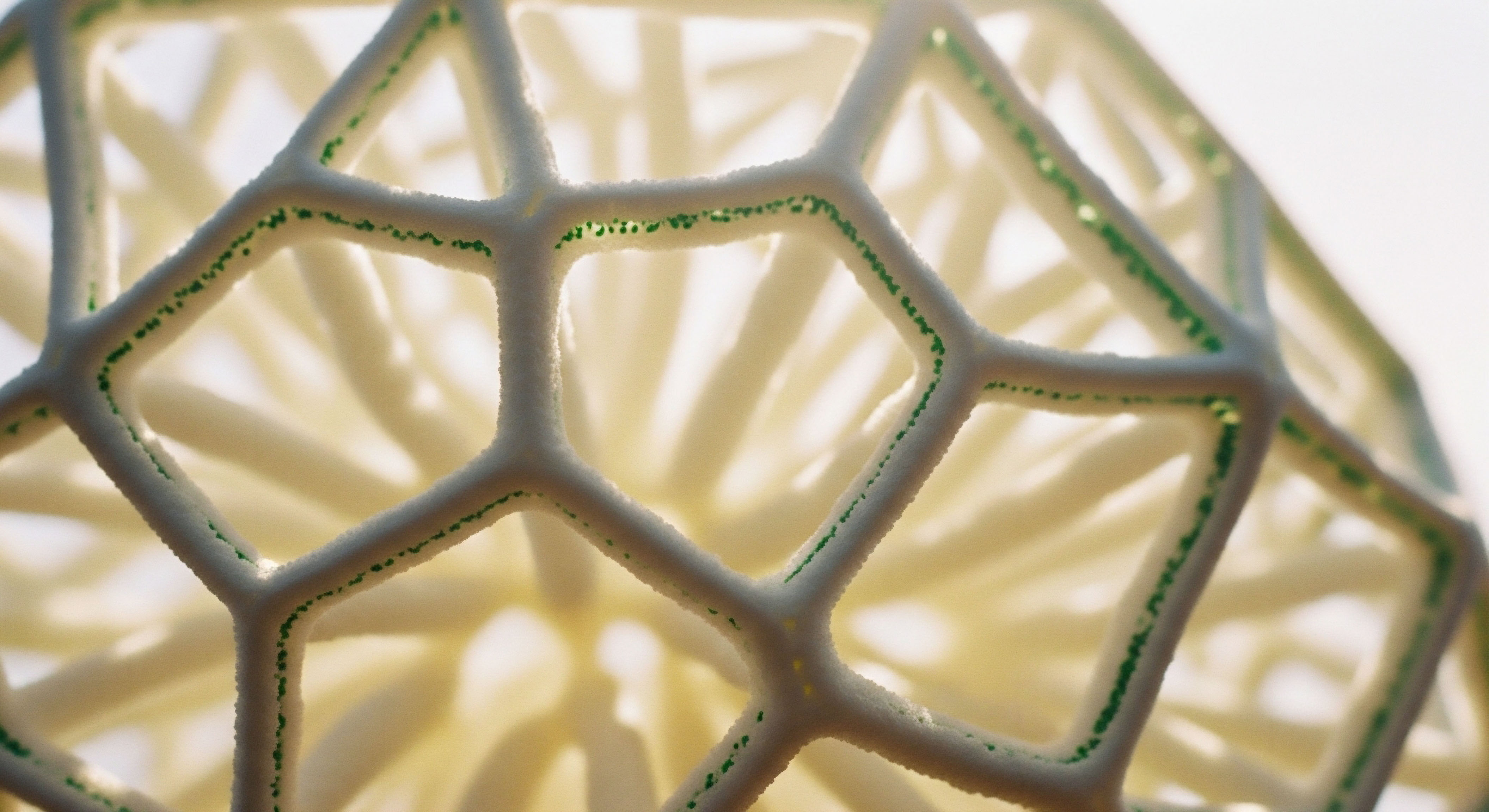

Fundamentals
You have likely observed the subtle shifts in your skin over time. A new line that catches the light, a change in texture, or a loss of that distinct firmness you once took for granted. These changes are a universal part of the human experience, a physical record of our lives.
Your body is communicating with you through the language of biology. Understanding this language is the first step toward consciously participating in your own health and vitality. The conversation about skin regeneration begins here, with the body’s own system of intricate messaging.
At the very heart of this biological communication system are peptides. These are short chains of amino acids, which are the fundamental building blocks of proteins. Think of proteins like collagen and elastin as the complex structures that give your skin its strength and flexibility ∞ the scaffolding and the elastic fibers.
Peptides, in this analogy, are the specialized work orders, the precise instructions delivered to the cellular construction crew. Their small size allows them to move through tissues and signal cells to perform highly specific tasks. This ability to direct cellular function is what makes them so foundational to regeneration.

The Architecture of Youthful Skin
To appreciate how peptides work, one must first understand the environment they influence. The skin is a complex, multi-layered organ. Its resilience and appearance are largely determined by the dermal layer, a dense matrix rich in two critical proteins:
- Collagen This is the most abundant protein in your body, providing the structural framework for your skin. It is responsible for its thickness, strength, and firmness. High-quality collagen production results in a smooth, robust dermal layer.
- Elastin This protein provides the snap-back, the elasticity that allows skin to return to its shape after being stretched or compressed. A healthy elastin network preserves the tautness and defined contours of the skin.
With age, and accelerated by environmental factors like sun exposure, the cellular machinery responsible for producing high-quality collagen and elastin becomes less efficient. The old, damaged proteins accumulate, and the production of new ones slows. This is the biological reality behind visible signs of aging. The communication breaks down, and the cellular work orders are sent less frequently and with less clarity.
Peptides act as precise biological messengers, instructing skin cells to perform specific regenerative functions.

How Can Peptides Restore Cellular Communication?
Targeted peptide therapies are designed to reintroduce those clear, potent messages back into the skin’s ecosystem. They function in a few distinct ways, each addressing the challenge of regeneration from a different angle. Some peptides are applied topically, delivering instructions directly to the skin cells. They might carry a message to ramp up collagen synthesis or to initiate repair processes. These are direct, localized signals designed to work on the surface and within the dermal layer.
Another class of peptides works systemically, from within the body. These peptides are administered to interact with the body’s master control systems, specifically the endocrine system. They stimulate the body’s own production of hormones that govern growth and repair.
This approach is based on the understanding that the health of your skin is a direct reflection of your internal hormonal environment. By restoring a more youthful hormonal balance, you create a body-wide state that is conducive to regeneration, impacting not just the skin but other tissues as well. This is a profound shift in perspective, viewing the skin as an outward expression of a fully integrated biological system.


Intermediate
Understanding that peptides are messengers is the first step. The next is to appreciate the sophistication of their messages and the different delivery routes they take. Targeted peptide therapies are not a monolithic category; they are a collection of highly specific tools designed to interact with the body’s regenerative systems in precise ways.
We can broadly categorize these into two main operational pathways ∞ locally acting peptides that deliver signals directly to the skin, and systemically acting peptides that influence the body’s hormonal environment to promote regeneration from within.

Direct Cellular Activation with Local Peptides
Locally acting peptides are those applied topically or delivered into the dermal layer to provide immediate, site-specific instructions. The most well-researched and clinically significant of these is GHK-Cu, a tripeptide with a strong affinity for copper ions. Its presence in the body declines with age, and its reintroduction has demonstrated a remarkable cascade of regenerative effects.

The Multifaceted Role of GHK-Cu
GHK-Cu is a prime example of a peptide that performs multiple roles in tissue remodeling. Its mechanism is a coordinated effort to clear out old, damaged tissue and build a new, healthy extracellular matrix. This process involves several simultaneous actions:
- Stimulation of Key Proteins GHK-Cu directly signals fibroblasts to increase the production of collagen, elastin, and glycosaminoglycans (GAGs). GAGs are crucial for maintaining skin hydration and plumpness.
- Tissue Remodeling It modulates the activity of matrix metalloproteinases (MMPs), which are enzymes that break down old proteins. Simultaneously, it stimulates their inhibitors (TIMPs). This balanced action ensures that damaged collagen is efficiently cleared away while preventing the excessive breakdown of healthy tissue.
- Anti-Inflammatory Action The peptide has potent anti-inflammatory properties, reducing the presence of inflammatory cytokines like TNF-alpha in the tissue. Chronic inflammation is a key driver of aging, so this calming effect is vital for creating a pro-regenerative environment.
- Wound Healing Cascade GHK-Cu attracts immune cells and endothelial cells to a site of injury or degradation. This promotes the formation of new blood vessels (angiogenesis), improving nutrient supply to the skin cells and accelerating repair.
GHK-Cu orchestrates a complex, localized process of clearing damaged tissue and synthesizing a new, healthy skin matrix.
The application of GHK-Cu, often through serums or in conjunction with procedures like microneedling, provides the skin with a direct biochemical blueprint for rebuilding itself. It is a targeted intervention aimed at restoring the skin’s own inherent repair mechanisms.
| Peptide Class | Primary Mechanism | Mode of Action | Primary Target | Expected Outcome |
|---|---|---|---|---|
| Signal Peptides (e.g. GHK-Cu) | Directly signals skin cells. | Local (Topical/Transdermal) | Fibroblasts, Immune Cells | Increased collagen/elastin, reduced inflammation, tissue repair. |
| Growth Hormone Secretagogues (e.g. Sermorelin, Ipamorelin) | Stimulates pituitary gland. | Systemic (Injectable) | Hypothalamic-Pituitary Axis | Increased endogenous Growth Hormone release, leading to systemic regeneration. |

Systemic Regeneration through Hormonal Optimization
The second major pathway for peptide therapy involves influencing the body’s endocrine system. As we age, the production of key anabolic hormones, particularly Human Growth Hormone (HGH), declines significantly. This age-related decline, known as somatopause, is directly linked to many signs of aging, including the thinning of the skin and the loss of collagen.
Growth Hormone Secretagogues (GHS) are peptides designed to counteract this decline. Compounds like Sermorelin and the combination of Ipamorelin with CJC-1295 do not introduce synthetic hormones into the body. They work by signaling the pituitary gland to produce and release its own growth hormone in a natural, pulsatile manner. This is a biochemical recalibration, restoring a communication pathway that has become dormant over time.

How Does Increased Growth Hormone Regenerate Skin?
Once released by the pituitary, GH travels through the bloodstream and exerts its effects throughout the body. For the skin, the pathway is clear and potent. GH stimulates the liver to produce Insulin-Like Growth Factor 1 (IGF-1), a powerful signaling molecule. IGF-1 then acts on fibroblasts in the skin, prompting them to synthesize new collagen and elastin fibers. The results are structural improvements from within:
- Increased Dermal Thickness Clinical evidence shows that restoring GH levels can increase the thickness of the dermis, making the skin more robust and resilient.
- Enhanced Collagen Synthesis The increased signaling from IGF-1 leads to a measurable uptick in collagen production, improving skin firmness and reducing the appearance of wrinkles.
- Improved Elasticity By supporting the health of the elastin network, these therapies help restore the skin’s ability to snap back, improving its overall tone.
This systemic approach views skin regeneration as one component of whole-body wellness. By restoring a more youthful hormonal milieu, you are creating an internal environment that is optimized for repair and growth, benefiting not just the skin, but also muscle tissue, bone density, and metabolic function.


Academic
A sophisticated approach to skin regeneration moves beyond a simple cause-and-effect model and embraces a systems-biology perspective. The vitality of the skin is a dynamic outcome of an intricate interplay between local cellular signaling, systemic endocrine function, and the underlying processes of cellular aging and repair.
Targeted peptide therapies offer a unique opportunity to intervene at multiple points within this complex system. The most advanced clinical strategies may involve the synergistic application of locally acting peptides, such as GHK-Cu, with systemically acting Growth Hormone Secretagogues (GHS) to create a comprehensive, multi-layered regenerative protocol.

The Molecular Mechanisms of GHK-Cu in Gene Modulation
The regenerative capacity of GHK-Cu extends beyond simple protein synthesis. Deeper investigation reveals its function as a modulator of gene expression. Studies have shown that GHK-Cu can reset the genetic activity of fibroblasts and other cells towards a more youthful, regenerative state. It has been demonstrated to influence a significant number of human genes, essentially up-regulating those associated with repair and down-regulating those associated with inflammation and tissue breakdown.
Specifically, GHK-Cu’s action on the extracellular matrix (ECM) is a tightly regulated process of remodeling. It stimulates the synthesis of not only collagen and elastin but also crucial proteoglycans and glycosaminoglycans like dermatan sulfate and decorin. Decorin is particularly important as it helps to organize newly synthesized collagen fibrils into a strong, coherent network.
Simultaneously, GHK-Cu has been shown to modulate the expression of matrix metalloproteinases (MMPs) and their tissue inhibitors (TIMPs). This dual regulation is the hallmark of controlled tissue remodeling, ensuring that the breakdown of senescent, damaged ECM components is precisely balanced with the synthesis of a new, functional matrix. This is a far more elegant biological process than simply stimulating collagen production alone; it is an orchestrated renewal.
Synergistic protocols combining local and systemic peptides may offer a more complete regenerative outcome by addressing both direct cellular signaling and the body’s underlying hormonal environment.

Endocrine Dermatology the Impact of Somatopause on Skin Integrity
The aging of skin is inextricably linked to the aging of the endocrine system. The decline in Growth Hormone (GH) and its primary mediator, IGF-1, is a central feature of the aging process, a phenomenon termed somatopause. This decline has profound and measurable consequences for the skin’s structural integrity. GH and IGF-1 are potent anabolic signals that maintain the proliferative and synthetic capacity of dermal fibroblasts. Their decline leads to a catabolic state within the dermis.
Research has quantified these changes. After the age of 30, collagen production is estimated to decrease by 1-2% per year. This results in a progressive thinning of the dermal layer, a reduction in the density of the collagen-elastin network, and a decrease in the hydration capacity of the skin due to lower GAG levels.
The use of GHS peptides like Sermorelin or Ipamorelin/CJC-1295 represents a direct intervention in this endocrine aging pathway. By stimulating the endogenous, pulsatile release of GH from the pituitary, these therapies aim to restore IGF-1 levels to a more youthful range.
This elevates the systemic anabolic tone of the body, shifting the dermal environment back towards synthesis and repair. Clinical studies involving GH-stimulating therapies have documented increased skin thickness and collagen deposition, providing clear evidence for this mechanism of action.

What Is the Synergistic Potential of Combined Peptide Protocols?
A truly advanced, systems-based approach would logically lead to the combination of these two therapeutic modalities. Consider the potential of a protocol that pairs a systemic GHS with a locally applied peptide like GHK-Cu. The systemic therapy (e.g. injectable Ipamorelin/CJC-1295) would work to restore the body’s overall regenerative potential by elevating GH and IGF-1 levels. This creates a body-wide environment that is primed for repair and growth.
Simultaneously, the local application of GHK-Cu (e.g. via a topical serum post-microneedling) would deliver a high-concentration, targeted signal directly to the dermal fibroblasts. This local signal would act in concert with the supportive systemic environment created by the GHS.
The GHK-Cu would orchestrate the specific, localized tasks of ECM remodeling, inflammation control, and angiogenesis, while the elevated IGF-1 levels provide the overarching anabolic stimulus for robust cellular activity. This theoretical synergy represents a powerful clinical model for achieving a more profound and durable state of skin regeneration.
| Biological Process | Systemic Peptide Contribution (GHS) | Local Peptide Contribution (GHK-Cu) | Potential Synergistic Outcome |
|---|---|---|---|
| Collagen Synthesis | Increases systemic IGF-1, providing a powerful anabolic signal to fibroblasts. | Directly stimulates fibroblast collagen mRNA and protein production. | Amplified and more efficient collagen production. |
| Inflammation Control | May have systemic anti-inflammatory effects through GH modulation. | Potently reduces local inflammatory cytokines like TNF-alpha. | Comprehensive suppression of age-related chronic inflammation. |
| Tissue Remodeling | Provides the anabolic environment necessary for building new tissue. | Directly modulates MMPs/TIMPs to clear old debris and organize new matrix. | Faster, more organized, and higher-quality tissue regeneration. |
| Cellular Vitality | Restores systemic factors that support cellular health and proliferation. | Restores replicative vitality to irradiated or senescent fibroblasts. | Improved health and function of the key cellular players in skin repair. |
This combined approach addresses both the ‘why’ of skin aging (systemic hormonal decline) and the ‘how’ of skin repair (local cellular mechanics). It is a representation of personalized, systems-oriented medicine, aiming to restore the body’s own intricate and powerful regenerative capabilities.

References
- Pickart, Loren, Jessica Michelle Vazquez-Soltero, and Anna Margolina. “GHK Peptide as a Natural Modulator of Multiple Cellular Pathways in Skin Regeneration.” BioMed Research International, vol. 2015, 2015, pp. 1-7.
- Choi, Franchesca D. et al. “Oral Collagen Supplementation ∞ A Systematic Review of Dermatological Applications.” Journal of Drugs in Dermatology, vol. 18, no. 1, 2019, pp. 9-16.
- “A Randomized, Double-blind, Placebo-controlled Clinical Study Investigating the Efficacy and Tolerability of a Peptide Serum Targeting Expression Lines.” The Journal of Clinical and Aesthetic Dermatology, vol. 14, no. 5, 2021, pp. E69-E75.
- Rudman, D. et al. “Effects of human growth hormone in men over 60 years old.” The New England Journal of Medicine, vol. 323, no. 1, 1990, pp. 1-6.
- Maquart, F. X. et al. “The tripeptide-copper complex glycyl-L-histidyl-L-lysine-Cu2+ stimulates matrix metalloproteinase-2 expression by normal skin fibroblasts.” FEBS Letters, vol. 444, no. 2-3, 1999, pp. 231-235.
- “Local and Systemic Peptide Therapies for Soft Tissue Regeneration ∞ A Narrative Review.” Cureus, vol. 15, no. 11, 2023, e48517.
- “Sermorelin Peptide Therapy in Oklahoma ∞ The Secret to Youthful Skin.” NP2GO, 2025.

Reflection
The information presented here provides a map of the biological territories involved in skin regeneration. It details the messengers, the pathways, and the systems that govern the health of your body’s largest organ. This knowledge is a powerful tool, shifting the perspective from passively witnessing change to actively understanding the processes behind it.
Your own body is a complex, responsive system, constantly working to maintain balance and function. The visible signs on your skin are just one dialect in a much larger conversation about your internal health.
Consider the interconnectedness of it all. A signal that begins deep within the brain’s pituitary gland can ultimately influence the firmness of the skin on your face. A microscopic peptide applied to the skin can initiate a cascade of repair that has been dormant for years.
This reveals a fundamental truth of human physiology ∞ no system operates in isolation. Your journey toward wellness is a personal one, and understanding the ‘why’ behind the science is the first, most crucial step. The path forward involves listening to your body’s unique signals and seeking guidance to interpret them with both scientific clarity and profound self-awareness.



